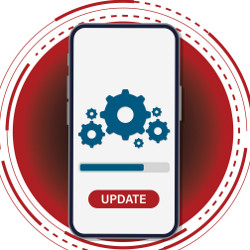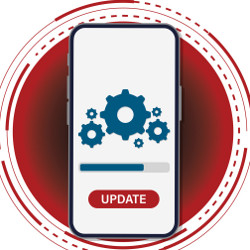
A dilemma derived from Shakespeare’s Hamlet is increasingly haunting company and security researchers: “to update or not to update, this is the question.” From the perspective of recommended common practices by software vendors the answer is unambiguous: You should keep your software up to date.8 But is common sense always good sense? We argue it is not.
Last year in a Communications article,4 Poul-Henning Kamp argued these industry best practices do not seem to work and a more radical reform is needed. In the same year, Massacci et al. recalled the SolarWinds attack was funneled by an update5 and a follow-up article7 indicated the recent protestware attacks are also channeled through updates.
What is wrong here is that updates are hardly classified as either functionality or security updates or both. They are bundled together for the convenience of the software vendor.6 For example, the WhatsApp update v2.19.51, while patching a critical security vulnerability exploited by the NSO Group, summarized the update with the following note: “You can now see stickers in full size when you long press a notification.” One might concede, without believing it, that conflating together functionality and security updates is done to make it more difficult to identify the vulnerable code.
Yet, this lack of transparency is not going to help. Organizations can only blindly accept the “black-box” cumulative update that will force them to install all updates ignored so far, or equally blindly ignore the popup. Still, updates might be normally good and might turn to be unwise only in the high-profile cases that hit the media.
We investigated whether this is the case in the context of Advanced Persistent Threats (APTs).2 APTs are sophisticated actors that deliberately and persistently target specific individuals and companies with a strategic motivation (from sabotage to financial gain). In this scenario, only an “all-hands on deck” defense seems appropriate and keeping your software up to date seems the bare—and likely not even sufficient—minimum.
Starting from “Operation Aurora” the security community increasingly released public information about APTs campaigns via blogs and technical reports. Unfortunately, the information is fragmented over different sources, each using different taxonomies to track adversaries. So, we collected data about more than 350 APT campaigns performed by 86 APTs in more than 10 years from more than 500 resources (and, by the way, the data is open sourcea). From this wealth of data, we can attempt to better understand these threats labeled “APT”s.
A as Advanced. In most cases, APTs do not even exploit a software vulnerability. Figure 1 shows the attack vectors employed in the campaigns. More than half of them do not employ any software vulnerability. APTs rely on spearphishing attacks via email and social networks to obtain the initial footprint in the network.

Figure 1. Attack vector campaigns and software vulnerabilities. More than half of the campaigns do not exploit software vulnerabilities but extensively rely on spearphishing to get initial access.
Whether your software is up to date makes no difference in at least 50% of the cases, as software vulnerabilities are not the main attack vector. The “all-powerful” attacker supporters could argue we are a victim of survival bias as we used data of security attacks that have been eventually discovered. As Richard Clayton said at the Workshop on Economics of Information Security on 2017, “we don’t always know if are measuring dim attackers getting caught rather than smart attackers getting through.” This is a valid point if we consider a single point in time. Eventually, even smart attackers will be, if not caught, at least spotted. For example, we can hardly say the Stuxnet and Solarwinds attacks were performed by unskilled attackers. Still, they have eventually been in the news. Thus, a decade of reports can give a reasonably accurate view of the attacker ecosystem. So let’s zoom in on the half of the attacks where software vulnerabilities did play some role.
P as Persistent. When APTs exploit software vulnerabilities, they often exploit vulnerabilities of which the vendor is aware and for which a patch is available. The 0-days exploits are not the norm. Figure 2 summarizes the number of campaigns that exploited known or 0-day software vulnerabilities. The 77% of the campaigns in our dataset rely on at least a vulnerability that was previously published on NVD at the time of the attack.

Figure 2. Classification of APT campaigns. Most of the campaigns exploited at least one vulnerability after reservation and publication by NVD. Only a few launched attacks exploiting unknown vulnerabilities that were neither reserved nor published by NVD.
This finding seems pretty solid evidence that software updates are actually useful. If APTs are exploiting software vulnerabilities that are known, and for which an update exists, then staying always on the edge of the newest Microsoft Office or Adobe Acrobat version should be enough to prevent the exploitation. Unfortunately, raw uninterpreted statistics of hindsight can be misleading. The first problem with the “Keep your software updated to the newest version” credo is the pace of updates is often very close to a Denial of Service against IT administrators with no improvement in security.1 Many updates are not security updates and updates tend to break other functionalities. Huang et al.3 in a paper aptly entitled “Up-to-Crash” determined many seemingly innocuous updates of vulnerable Android libraries might crash the dependent application approximately 50% of the time.
So we decided to investigate the potential effectiveness of keeping the software up to date for five widely used software products in the decade under study (Office, Acrobat Reader, Air, JRE, and Flash Player) from three major software companies (Adobe, Microsoft, and Oracle) for the Windows OS with different strategies.
The Ideal strategy represents the unrealistic scenario of staying on the edge of the wave and update the software as soon as a new release is available. The software vendor’s speed is the only limiting factor.
The Industry strategy is a more realistic representation of the dutiful organizations that follow the industry best practices and apply each new update with some delay between the release of an update and its installation to perform regression testing. Delay ranges from one week to several months.
A more relaxed Reactive strategy just focuses on updating when a CVE for a software vulnerability is published in a database of vulnerabilities like NVD.
T as Threat. As we (now) know when the attack took place with some approximation (that is, almost all reports only indicate the month of the attack), we can calculate the Agresti-Coull 95% confidence interval that doing an update at that time was actually useful or not. In other words, we can calculate the conditional probability that you would have updated on the same month, or updated the next month when the update became available and still have succumbed to an APT—if they ever decided to target you.
Figure 3 shows the range in which the probability of being compromised lies for the different strategies considering a one-month delay for the Industry and Reactive strategies to perform regression testing. When the intervals overlap it means the two strategies are not statistically distinguishable. That is very bad news for the IT administrators that struggled to keep pace of the updates.

Figure 3. Agresti-Coull confidence interval of the probability of being compromised for update strategies (one month delay for Industry and Reactive strategies).
In Figure 3 we observe that either an enterprise applies at light-speed lots of updates (the Ideal strategy) or the risk of being compromised once you have to wait to perform regression testing for all new releases of the software (Industry strategy) is the same as if you just wait for a CVE to come out (Reactive strategy) but the latter saves you from a lot of useless updates. Furthermore, even if we are keeping our system up to date at light-speed, we also need to be lucky to not jeopardize our effort. Indeed, if we consider the worst-case scenario of a strategy, where APTs are slightly faster to exploit than enterprises to patch (that is, on the same month), the probability of being compromised significantly overlaps with the more relaxed strategy of waiting for a CVE to be published.
All-speedful defenders are as unrealistic as all-powerful attackers, thus it seems perfectly rational to save time and money and only rush to update for disclosed vulnerabilities and before that do nothing. That is what most company seems to do and get lambasted for.
What is the answer? If the “keep your systems up to date” best practice is only effective when the enterprises spend most of their resources on fixing and maintaining their suppliers’ software instead of servicing their own customers, then why do we stick with this recommendation?
This is a best practice that can be included in the “security theater,”8 nine measures that provide minimal benefits and are not worth the cost.
As Kamp points out in his Communications article,4 this industry ‘best practice’ allows cyberinsurance companies to reject requests for coverage. Most importantly, it allows software companies to shift liability toward their “lazy” users. For the software vendors (starting from the big four), this best practice is the most desirable because releasing an update that “improves” an unknown feature of a product is much easier than implementing it as a secure application with mechanisms like automatic network segmentation and escalation and execution confinement6 and without unnecessary frills.
We agree with Poul-Henning Kamp: it is good time to introduce the “right to not update”5 and return the liability of defective software building to the software builders and not to the software users.4
Administrators at the U.S. Capitol or Brussel’s Berlaymont should take notice of the copy of the old Code of Hammurabi reported in the table here along with its counterpart in the IT reign. It is for the future to align its liability laws to the past.

Table. The IT code vs. the building code of Hammurabi.
To summarize: If “How to have more security?” is the question, software updates are not the answer.




Join the Discussion (0)
Become a Member or Sign In to Post a Comment